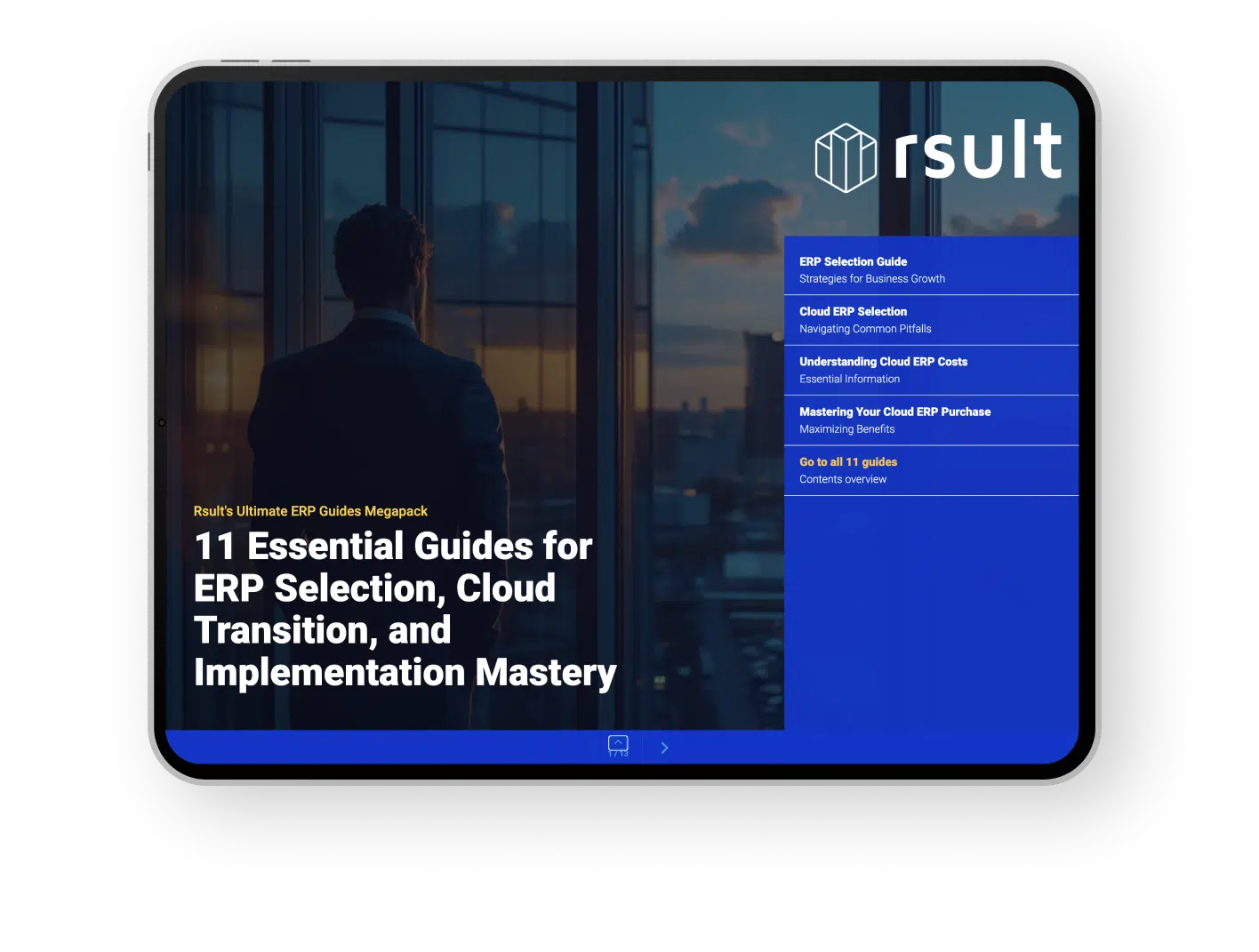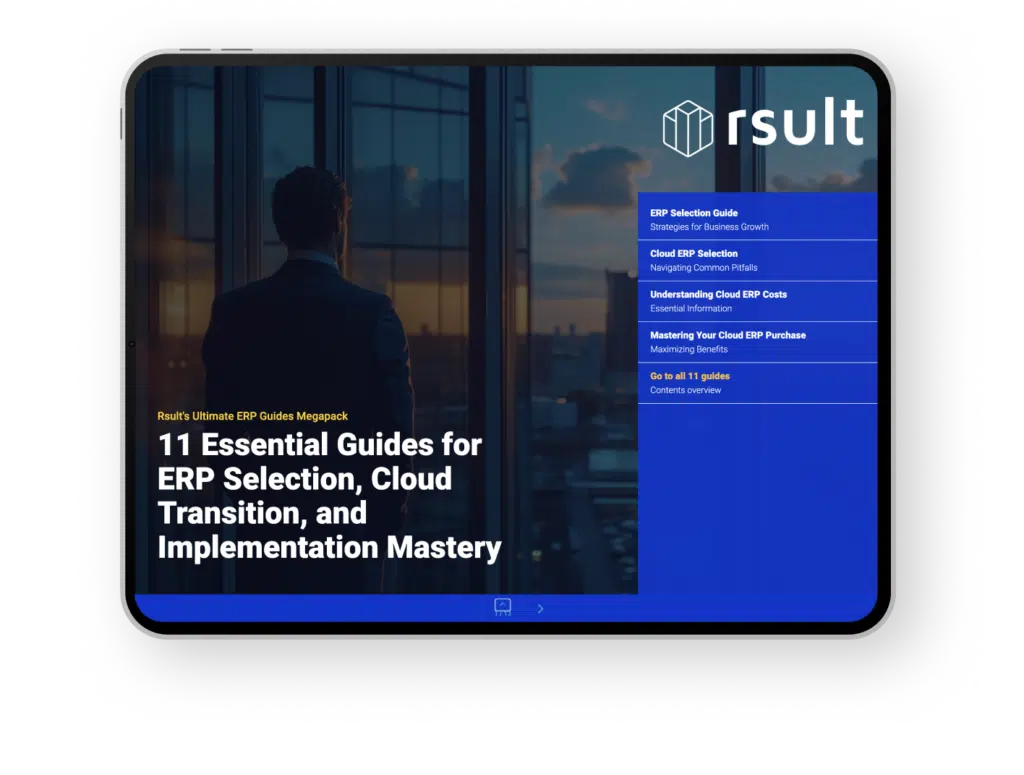In the era of digital transformation, an efficient ERP system implementation stands as the cornerstone for companies aiming to streamline their operations. The integration of finance, HR, inventory management, and other functional areas into a seamless ecosystem not only optimizes processes but also paves the way for substantial growth. However, navigating the journey of ERP project management requires a strategic approach, one that is anchored by a concrete understanding of ERP implementation steps and guided by ERP deployment best practices.
The rewards of a well-executed ERP implementation are substantial, offering enhanced productivity and a solid foundation for informed decision-making. Businesses today are increasingly recognizing the importance of adopting ERP solutions tailored to their specific needs, enforcing the idea that a one-size-fits-all approach is no longer viable.
Key Takeaways
- Unveil the significance of a cohesive approach to ERP system implementation for business integration.
- Unpack the steps critical to ERP project management to ensure seamless deployment and adoption.
- Explore ERP implementation steps as a blueprint for successful digital transformation.
- Detail ERP deployment best practices that can lead to increased efficiency and cost savings.
- Recognize the potential for ERP systems to revolutionize how businesses operate and strategize.
Demystifying ERP System Implementation
Implementing an Enterprise Resource Planning (ERP) system is no small feat. It requires a concerted effort to align technological capabilities with business objectives. As organizations look to adopt ERP systems, understanding the nuances of ERP software integration and configuration is paramount. Far from just an IT project, ERP system configuration presents an opportunity for businesses to revolutionize their operations.
Defining the Scope and Impact on Businesses
ERP system implementation empowers enterprises by providing a unified, comprehensive view of their inner workings. By analyzing and setting the business scope, companies can anticipate the broader impact of ERP software integration on their daily processes. This strategic move goes beyond mere software installation; it is about reimagining how business functions intersect and interact.
The Strategic Role of ERP in Integrating Business Functions
The real magic lies in the strategic role ERP plays in integrating various business functions. By breaking down silos and facilitating communication across departments, integrated ERP systems pave the way for heightened efficiency. To achieve this harmonious state, meticulous ERP system configuration is key, ensuring that the software reflects the unique workflow of the enterprise.
Below is a table illustrating the transformative impacts of a strategically implemented ERP system:
| Business Function | Before ERP Integration | After ERP Integration |
|---|---|---|
| Accounting and Finance | Manual data entry, prone to errors | Automated, real-time financial reporting |
| Human Resources | Disjointed employee information management | Centralized HR database with self-service portals |
| Supply Chain Management | Inconsistent inventory tracking | Integrated supply and demand planning |
| Customer Relations | Fragmented customer data | Unified customer relationship management |
Ultimately, diving into ERP software integration and system configuration can be transformative for any business, leading to greater visibility, more informed decision-making, and ultimately, a sustainable competitive edge.
ERP System Implementation Roadmap
Embarking on ERP system implementation requires a strategic approach to ensure it aligns with business objectives. A well-crafted roadmap not only streamlines the process but also minimizes the risks associated with ERP adoption.
Charting the Course: Key Planning Stages
Defining the project scope sets the foundation for ERP implementation. During this stage, businesses must determine the processes to be enhanced by ERP system customization and identify ERP implementation consultant partners who will aid in seamlessly bringing the new system online. Establishing a clear set of goals and project timelines is crucial to ensure that every subsequent step adheres to the strategic plan.
Assembling Your Implementation Team
Creating a capable and dedicated project team is vital for the success of your ERP venture. Including decision-makers and key users from each department ensures that all business needs are adequately represented. By fostering cross-functional collaboration, businesses can leverage a diverse set of insights and expertise throughout the ERP implementation process. An executive sponsor plays an essential role in driving the project forward and securing the necessary resources.
- Executive Sponsor
- Leadership and decision-making authority
- Resource allocation
- Project Manager
- Coordination of all project activities
- Primary liaison between business and ERP implementation consultant
- IT Specialists
- Technical expertise in ERP system customization
- Infrastructure and data security management
- Department Representatives
- Functional insights and requirements
- User training and feedback
With an efficient team structure, businesses position themselves for a successful transition to their chosen ERP solution, ensuring the final platform is tailored to unique needs and practices.
| Project Phase | Key Activities | Team Members Involved |
|---|---|---|
| Initiation | Define scope, objectives, and success metrics | Executive Sponsor, Project Manager |
| Planning | Create a comprehensive project plan and timeline | Project Manager, IT Specialists, Department Representatives |
| Execution | Perform ERP system customization and integration | IT Specialists, ERP Implementation Consultant |
| Monitoring & Control | Track progress, manage changes, ensure quality | Project Manager, Department Representatives |
| Closure | Finalize implementation, conduct post-implementation review | Executive Sponsor, Project Manager, ERP Implementation Consultant |
Following a methodical implementation roadmap, businesses can significantly enhance the chances of a successful ERP rollout, fully optimized for their operational requirements.
Essential Steps in ERP Software Integration
Understanding the ERP implementation steps is fundamental to any business looking to streamline processes and enhance overall productivity. A successful integration commences with a meticulous selection of a vendor renowned for industry excellence and comprehensive ERP training and support services. The journey from initiation to completion involves various critical phases, each demanding careful attention to ensure a smooth and effective ERP software integration.
Customization and system configuration are pivotal steps in aligning ERP software with specific business needs. This process requires the collaboration of all departments, ensuring their requirements are captured and implemented with precision. Next, data migration takes the stage, a task that confirms the accuracy and integrity of all business data as it is transferred to the new system.
- Vendor Selection: Choose a vendor with a strong track record for reliability and support.
- System Customization: Tailor the system to align with unique business processes.
- Data Migration: Meticulously transfer data ensuring completeness and accuracy.
- User Training: Implement comprehensive training programs tailored to the various roles within the organization.
Furthermore, ERP training and support cannot be overstated when it comes to fostering a smooth transition to the new system. In-depth training tailored to different user roles ensures that each member of the organization is well-equipped to leverage the new system to its fullest potential.
| Phase | Focus Areas | Expected Outcomes |
|---|---|---|
| Vendor Selection | Track record, Industry experience, Support quality | A reliable partner to support system integration |
| System Customization | Alignment with business processes, Employee input | An ERP solution that reflects the organization’s workflow |
| Data Migration | Data accuracy, Integrity protocols | Seamless transition of business data |
| User Training | Role-specific sessions, Training resources | Empowered employees ready to use the ERP system |
In essence, the journey of ERP software integration is deliberate and structured. Each step, from beginning the journey with an industry-leading vendor to implementing thorough ERP training and support, is instrumental in shaping a robust ERP system that stands the test of time and drives business productivity.
Selecting the Perfect ERP Platform
Embarking on the journey of ERP vendor selection is no small task for any business. The right vendor not only offers advanced features to cater to your business needs but also supports your company’s growth in the long term. When considering ERP options, it’s crucial to evaluate how ERP implementation services and the platform itself will help streamline operations, manage resources more efficiently, and provide insightful reporting for decision-making.
Understanding the importance of scalability ensures that the chosen ERP solution grows with your organization. In the evolving business landscape, the agility provided by a scalable platform is invaluable. A vendor’s reliability and reputation in the market often serve as an indicator of the service quality and longevity you can expect.
While the upfront cost of acquisition is a factor, it’s essential to think beyond the initial expense. Comprehensive cost considerations include long-term maintenance, software updates, and the availability of ERP implementation services that ensure your ERP system continues to meet evolving business demands.
Compatibility is another key aspect; the ERP platform must align seamlessly with your current business processes. Catering to industry-specific needs, the software should offer functionalities such as financial management, supply chain oversight, customer relationship management (CRM), and human resource management without disrupting existing workflows.
- Scalability for growth and expansion
- Vendor reputation for consistent reliability
- Transparent cost analysis for total ownership
- Alignment with existing business processes
- Core features for financial, CRM, and HR modules
- Comprehensive ERP implementation services
Making the right ERP vendor selection is a fundamental step that shapes the future of organizational processes and efficiency. Careful consideration and alignment with your business objectives guide you toward an ERP platform that harmoniously blends with your business’s unique ecosystem.
Customizing ERP Systems to Fit Unique Business Needs
Understanding that each business has its distinctive processes and challenges, ERP system customization must be approached with precision and strategy. To tailor an enterprise resource planning (ERP) system that delivers on its promises, focusing on the alignment of software capabilities with business operations is essential. Below we delve into the considerations for ERP system configuration and how modular customization can significantly uplift business functions.
ERP System Configuration Considerations
At the heart of ERP deployment best practices lies a thorough system configuration. This aspect of ERP system customization involves an in-depth analysis and restructuring of various organizational components to fit the ERP software. Key considerations include:
- Accurately reflecting the company’s hierarchy and reporting structures within the ERP.
- Defining charts of accounts to accommodate the financial reporting complexity.
- Setting up cost centers to track and manage expenses effectively.
- Delineating business units for clearer operational oversight and performance assessment.
It’s this level of customization that not only ensures that the ERP system mirrors the current business model but also scales with future growth and changes.
The Role of Modular Customization in ERP
Modular customization is a cornerstone of ERP system customization, enabling businesses to enhance functionalities in specific departments while maintaining a cohesive system. This approach supports individual business area needs, from financial management to customer relationship management (CRM), without overhauling the entire system:
| Business Area | Benefits of Modular Customization |
|---|---|
| Financial Management | Improved budget control, real-time financial reporting, and compliance tracking. |
| CRM | Enhanced customer data management, sales forecasting, and service optimization. |
| Supply Chain | Better inventory oversight, demand planning, and logistic coordination. |
| Human Resources | Streamlined staff recruitment, payroll processing, and performance evaluations. |
By adopting these ERP deployment best practices, companies ensure that their ERP system customization is not only comprehensive but also robust enough to support each business area’s unique demands.
Transferring Data to Your New ERP System
When embarking on ERP data migration, it’s critical to acknowledge the complexity of the task. Migrating to an ERP system presents a unique challenge that requires meticulous planning, strategic execution, and a thorough understanding of the intricacies involved. A seamless ERP system integration can significantly improve your organization’s data processes and ensure that your day-to-day operations run more efficiently.
Data Migration Strategies for Seamless Integration
To initiate the process of ERP data migration, developing a comprehensive data migration plan is essential. This involves identifying which data will be moved, understanding the format changes required, and ensuring legacy system compatibility. Below are vital steps to consider:
- Data Mapping: Matching data fields from the old system to the new ERP system to ensure consistency.
- Data Cleansing: Removing or correcting any data that is inaccurate, incomplete, or outdated.
- Trial Migrations: Conducting preliminary data migrations to validate the process prior to the final move.
These strategies are fundamental to achieving a successful ERP data migration, reducing the risk of data loss and system integration issues.
Ensuring Data Integrity Across Platforms
Maintaining the integrity of your data during and after the migration is paramount. Data governance policies should be established to uphold data quality. Here are key practices to ensure data integrity:
- Perform routine data quality checks both before and after migration.
- Implement robust data validation rules to catch errors.
- Create a detailed documentation trail for auditing and compliance purposes.
With these data governance measures in place, ERP system integration will be more resilient to the common challenges that compromise data integrity.
To visualize how in-depth ERP data migration can be, let’s consider the following table that outlines data elements and their corresponding actions:
| Data Element | Action Required | Challenges | Risk Mitigation Tactics |
|---|---|---|---|
| Customer Information | De-duplication and standardization | Inconsistent data entries | Define clear data standards before migration |
| Financial Records | Mapping to new chart of accounts | Complexity in reconciling accounts | Conduct financial data reconciliation pre- and post-migration |
| Inventory Data | Conversion to the new unit of measure standards | Differences in inventory tracking methodologies | Implement a conversion process that is tested thoroughly |
| HR Records | Ensuring compliance with new data privacy regulations | Adaptation to new privacy standards | Prior review of regulatory compliance requirements |
Undertaking ERP data migration is a transformative step forward for any organization looking to integrate an ERP system successfully. Attention to detail and adherence to best practices are what differentiate a successful migration from one that falls short. Remember, the ultimate goal is to transport your valuable data securely and effectively, setting the stage for improved data handling and decision-making within your ERP system.
User Training for Effective ERP Adoption
Implementing a new ERP system is a colossal step towards organizational efficiency and integration, but the crux of its success lies in effective ERP user adoption. It is understanding the ‘human factor’ which ensures that your investment is not just an advanced technological installation but a pivot for elevating the skills and productivity of your workforce. Recognizing this, ERP training and support becomes an invaluable component of the overall strategy for implementing an ERP system.
Comprehensive training programs are designed to cater to different learning styles and paces, enhancing user engagement and confidence in utilizing the new system. We prioritize hands-on training, where users dive into the actual ERP environment, navigating through real scenarios and tasks they will encounter in their daily work life. This approach helps in solidifying understanding and encourages practical problem-solving skills among employees.
- Interactive online tutorials provide convenience and flexibility, allowing employees to gain knowledge at their own pace.
- In-person sessions are conducted for more personalized feedback and to tackle complex topics.
- Mentoring programs link novice users with experienced ones, creating a knowledge-sharing infrastructure that reinforces ERP training and support.
Accessible support resources play a fundamental role post-training, as users continue to adapt and optimize the ERP system in their routine. From user manuals and FAQs to help desk support, these resources are crucial for ongoing support and user empowerment.
In the journey to maximize ERP user adoption, training should not be seen as a one-time event but an evolving process that keeps pace with system updates, changing processes, and the continuous development of your human capital. A fully supported ERP system is a testament to an organization’s commitment to not just technology, but also to its people who make technology work.
Testing Phases in ERP Deployment Best Practices
Ensuring the success of an ERP software integration hinges critically on detailed ERP testing and quality assurance. The rigors of testing are designed to validate the robustness of the deployment: a task that must be approached meticulously. Testing phases break down into several stages, each with its own focus, to affirm system integrity and performance excellence.
Initially, tests concentrate on each module, confirming that individual features perform as expected. As testing progresses, it extends to examining the interactions between modules, proceeding to full-scale end-to-end tests. This holistic approach assists in ensuring all parts of the ERP solution work harmoniously, effectively mirroring real-world scenarios users will encounter.
- User Experience Checks: Scrutinizing the ERP from the standpoint of the end user, assessing readability and navigability of the interface.
- Security Audits: Gauging the system’s defenses against unauthorized access, protecting sensitive business data.
- Functionality Trials: Rigorous inspection of all ERP functionalities to affirm they meet predefined criteria and operate flawlessly.
- Integration Examination: Verifying seamless interaction with existing systems, confirming data flows correctly throughout the enterprise architecture.
- Performance Analysis: Validating the system’s efficiency under various load conditions, ensuring stability and speed.
ERP software integration is not complete without a comprehensive phase of user acceptance testing (UAT). During UAT, actual system users verify that the ERP platform aligns with business processes. This phase is fundamental as it facilitates feedback from those who will use the system daily, ensuring the ERP solution effectively supports their workplace requirements.
The iterations of testing, corrections, and enhancements leading up to deployment are pivotal. They are the guardians of quality assurance, the assurance that the application will not only function but also thrive as the backbone of an organization’s operations.
As vital as these testing phases are, paramount is the establishment of a responsive feedback loop. This loop ensures that issues, once identified, are promptly addressed, reinforcing the system’s capabilities. Flawless ERP deployment is not a serendipitous event; it’s the culmination of a disciplined approach to testing, with a relentless focus on ERP testing and quality assurance. The methodology behind this assures that when the system finally goes live, it is not merely operational but primed for peak functionality—from its core infrastructure to the outermost user interface.
Maximizing Results with ERP Project Management
Efficient ERP project management is the cornerstone of a successful ERP system implementation. A focused approach, anchored in industry best practices, is crucial to steer the multi-faceted process towards a successful conclusion. As such, project managers must not only drive the process forward but also ensure every aspect aligns harmoniously with the established goals and objectives.
At the heart of this dynamic process is the ability to adapt quickly to unforeseen challenges while keeping the project’s scope firmly in view. Handling resistance to change and setting realistic timelines are imperative for maintaining momentum and securing stakeholder buy-in. Detailed tracking mechanisms help in monitoring progress, equipping managers to make informed decisions as they guide their teams through complex ERP landscapes.
ERP system implementation is not only a technical venture but one that impacts every level of an organization; thus, communication and resource management become essential tools for any project manager. Balancing these tasks, while promoting collaboration across departments, encapsulates the true skill in ERP project management.
| ERP Project Management Best Practice | Benefit |
|---|---|
| Clear Definition of Project Scope | Ensures that all team members understand the boundaries and objectives of the ERP implementation |
| Milestone Tracking | Provides a benchmark for progress and helps to keep the project on schedule |
| Resource Allocation | Optimizes the use of both human and financial resources throughout the implementation process |
| Change Management | Minimizes resistance and facilitates smoother transition to new processes |
| Risk Mitigation | Proactive identification and management of potential issues before they escalate |
Ultimately, effective ERP project management aids in realizing productivity gains, efficiency improvements, as well as financial benefits – all of which are critical success metrics for an ERP system implementation. Embracing these practices ensures that the implemented ERP system functions as the transformational tool it’s intended to be, propelling the organization into a future of streamlined operations and enhanced decision-making capabilities.
Conclusion
The venture into ERP system implementation represents a pivotal transformation that demands rigorous attention to detail and adherence to established best practices. From initial planning phases to the final deployment, each stage of the journey requires a steadfast commitment to the vision of streamlined business processes and data-driven insights. Perhaps most critical in this extensive process is the alignment of the ERP platform with the unique needs of your business, ensuring that the selected system is not just a tool, but a foundational element that propels the business forward.
Engagement with stakeholders, assiduous system customization to meet specific organizational requirements, comprehensive testing to preclude potential hurdles, and detailed user training—these are the cornerstones that pave the way for a thriving system implementation. For firms embarking on this journey, it’s essential to recognize that ERP deployment best practices are not just guidelines, but instrumental steps that culminate in the optimal functioning and realization of the ERP system’s swath of benefits.
By harnessing a methodology that prioritizes ERP deployment best practices at each implementation phase, companies are far more equipped to navigate the complexities of ERP system implementation. Measuring the success of this endeavor goes beyond operational efficiency to encompass the degree of integration into the company’s core activities. In essence, a well-executed implementation synthesizes technology with business strategy, manifesting in enhanced capability, scalability, and ultimately, superior overall performance.






